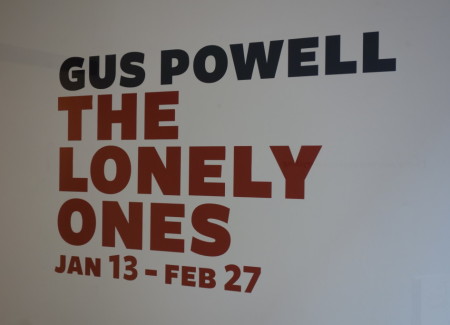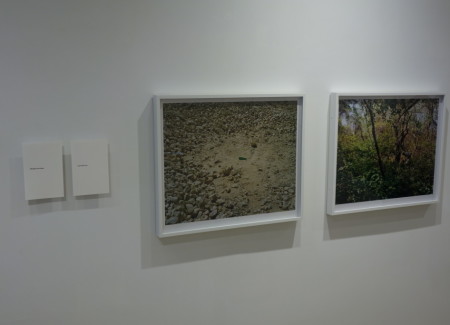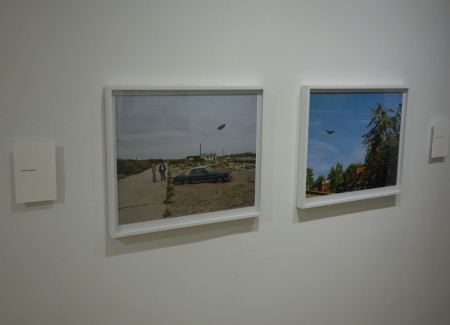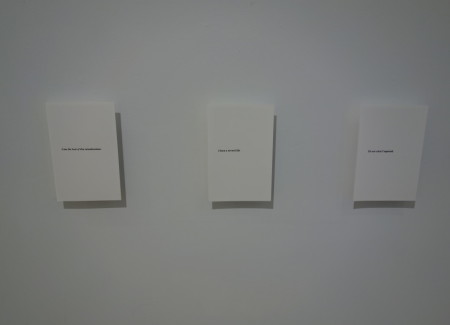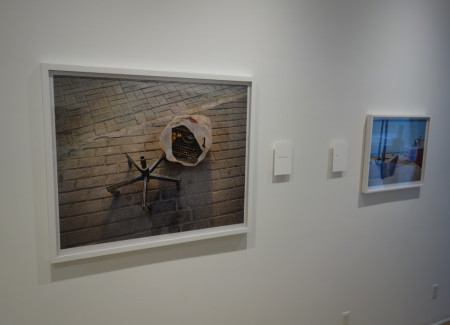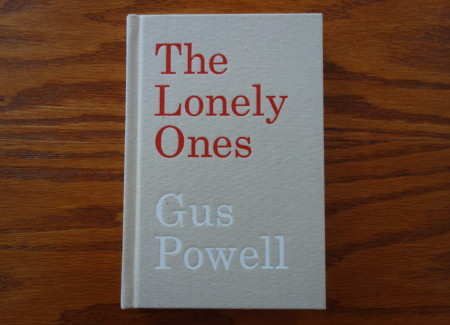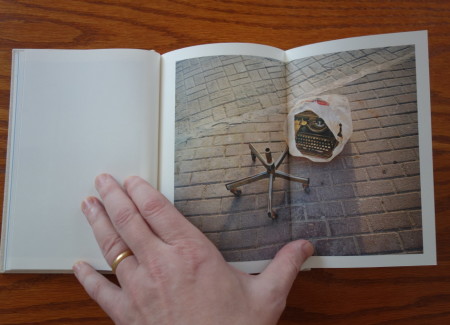JTF (just the facts): A total of 15 color photographs, framed in white and unmatted, and hung against white walls in the main gallery space. All of the works are chromogenic prints, made in 2015. The prints are shown in two sizes: 20×24 (in editions of 8) and 30×40 (in editions of 4). There are 3 large prints and 12 small prints on view. Each image is accompanied by a corresponding letterpress title block. A monograph of this body of work was published in 2015 by J & L Books (here) and is available from the gallery. (Installation shots below.)
Comments/Context: While many gallery shows have tried their best to emulate the sequencing and flow of now famous photobooks, few have replicated the rhythmic experience of paging through a photobook as closely as this exhibit of images from Gus Powell’s project The Lonely Ones.
Fidelity to the original matters here because the book itself is so cleverly constructed. In Powell’s intimately-sized photobook, each of the images is hidden behind an individual gatefold, with a short text or phrase printed on the folded front, forcing the reader to engage with the text before opening the flap to see the image underneath. This “text first” approach (inspired by a similarly titled book by cartoonist William Steig) reverses the usual “image first” model of a title or caption discovered only after looking at and digesting the associated photograph, and allows Powell to consciously frame our experience of each picture up front – his book (and its accompanying exhibit) is one to be read, the weight of the text and images in more even balance than usual. On the walls of the gallery, this experience is echoed via mounted pages from the book set right alongside the images, the similar alternating cadence slowing us down (just as the unfolding/refolding of each page turn did) and forcing us to engage with each pairing with deliberate attention.
Powell’s photographs capture in-between moments in both urban and rural settings, where city streets and landscapes alike are sparsely populated and the action being captured is often open-ended and undefined – a solitary man appears to bag something in the undergrowth of a dead tree, a pair of muddy tire tracks lead off into the fog, and a woman exits the subway near a tarp covered vacant lot. These single frame vignettes and quietly surreal stories are meaningfully enhanced by the presence of Powell’s texts. With his words as a guide, we see the overlooked magic in a circle of rainbow-colored lawn chairs strewn around a beach fire pit or an empty road sign pointing to a snowy nowhere.
Some of the best pairings on view in this show match a subtle poignancy with the voice of an interior monologue, as if we can somehow read the minds of the characters or have an omniscient narrator filling in the various backstories. A change of heart watches as a woman stands in the street with a white umbrella on an otherwise sunny afternoon and looks toward an overgrown garden; with just those few words, we attribute a sense of longing and melancholy to her pose. I am the host of this misadventure adds a resigned frustration to an image of a mother on the street carrying a bag and a baby in the beating sun, the ridiculous futility of the situation enhanced by her thought bubble. And I don’t think too much about happiness chronicles a white car traversing an intersection filled by dense smoke, the image now full of the muted loneliness of isolation.
Other pairings crackle with the wry knowing humor of a well-placed one liner. Ungrateful bastards find two men glumly appraising a car stuck in the sand. Let’s not ruin it by talking applies a relationship maxim to an oddball image of a woman facing a horse in the layered space of a city sidewalk, their two pony tails set off in opposition. And Mistakes were made tells the story of an empty bottle left amid the flat bottom of a rock pile, the imaginary transgressions coming from such a scene spinning out in all directions.
The careful ambiguity in Powell’s photographs opens up the broad opportunities for his textual associations and reconsiderations. Men on a beach boardwalk, a butterfly in flight, a typewriter in a bag – these mundane things are all the first lines of stories, and Powell is only too happy to use his spare words point us in one direction or another. His elegantly integrated phrases and pictures are rethinking how contemporary photographic narratives can be built, turning found oddities into catalysts for further wanderings of the mind.
Collector’s POV: The works in this show are priced as follows. The 20×24 prints are $3000 each and the 30×40 prints are $5000 each. Powell’s work has little secondary market history, so gallery retail remains the best option for those collectors interested in following up.
